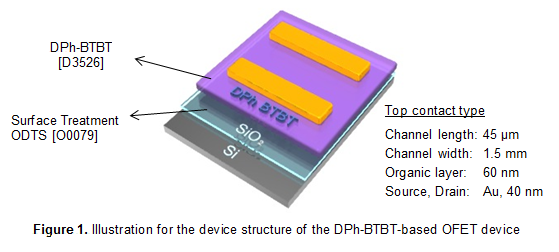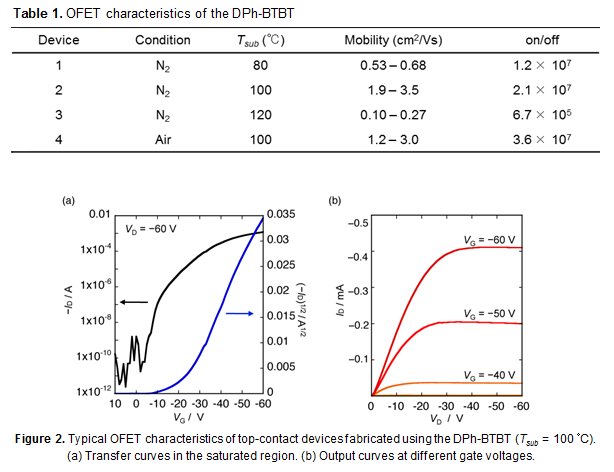Published TCIMAIL newest issue No.197
Maximum quantity allowed is 999
DPh-BTBT: High-mobility and Air-stability p-type OFET Material

TCI have commercialized “the DPh-BTBT: high-mobility and air-stability p-type OFET material”, and also have started fabrication and evaluation of OFET devices in our laboratory.
- K. Takimiya, H. Ebata, K. Sakamoto, T. Izawa, T. Otsubo, Y. Kunugi, J. Am. Chem. Soc. 2006, 128, 12604.
DPh-BTBT-based OFET Device Fabrication and Evaluation
The field-effect mobility of DPh-BTBT was measured using the top-contact thin-film field-effect transistors geometry (Figure 1). The thin film of DPh-BTBT as active layer (60 nm) was vacuum-deposited onto octadecyl trichlorosilane (ODTS)[O0079]-treated Si/SiO2 substrates at different substrate temperatures (Tsub = 80, 100 and 120 ℃). The drain and source electrodes (40 nm) then were prepared by gold evaporation through a shadow mask on top of the DPh-BTBT film; the drain-source channel length (L) and width (w) are 45 µm and 1.5 mm, respectively. The characteristics of the OFET devices were measured under nitrogen or ambient .conditions.

The performances of the OFET devices are summarized in Table 1. All DPh-BTBT-based devices exhibited pure typical p-channel field-effect transistor (FET) characteristics. The FET mobilities were quite dependent on Tsub; the device fabricated at Tsub = 100 ℃ demonstrated the highest performance with a hole carrier mobility of 3.5 cm2/Vs, and an on/off ratio of 2.1 × 107 under the nitrogen conditions (Figure 2). Interestingly, in the ambient condition, the DPh-BTBT-based device also demonstrated excellent typical p-channel FET characteristics with a high hole mobility of 3.0 cm2/Vs. These results indicate that DPh-BTBT is a promising p-type OFET material possessing high hole mobility and good air-stability.


